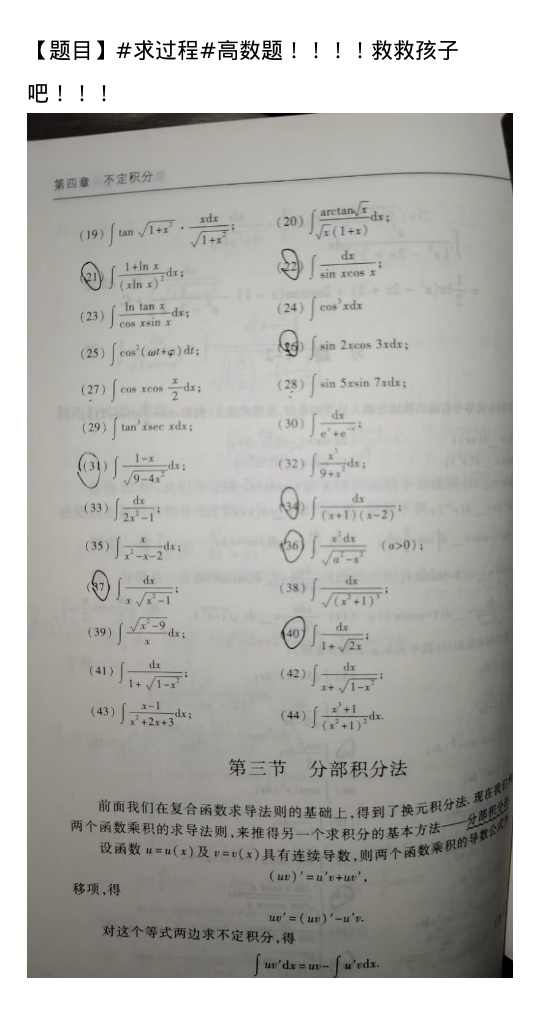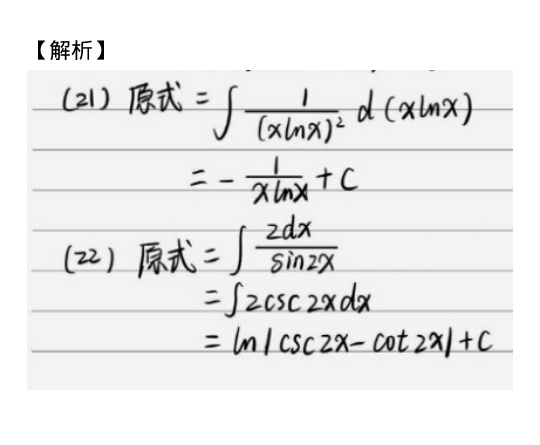题目
(19) int tan sqrt (1+{x)^2}cdot dfrac (xdx)(sqrt {1+{x)^2}}-|||-(20) int dfrac (arctan sqrt {x)}(sqrt {x)(1+x)}dx-|||-21 int dfrac (1+ln x)({(xln x))^2}dx;-|||-int dfrac (dx)(sin xcos x);-|||-(23) int dfrac (ln tan x)(cos xsin x)dx;-|||-(24) cos^3xdx-|||-(25) int (cos )^2(omega t+varphi )dt;-|||-bigcirc (16)int sin 2xcos 3xdx;-|||-(27)int cos xcos dfrac (x)(2)dx;-|||-(28)|sin5xsin 7xdx;-|||-(29)int (tan )^3xsex xdx;-|||-(30) int dfrac (dx)({e)^x+(e)^-x};-|||-(3) int dfrac (1-x)(sqrt {9-4{x)^2}}dx;-|||-(32) int dfrac ({x)^3}(9+{x)^2}dx;-|||-(33) int dfrac (dx)(2{x)^2-1};-|||-3 int dfrac (dx)((x+1)(x-2))-|||-(35) int dfrac (x)({x)^2-x-2}dx;-|||-36 int dfrac ({x)^2dx}(sqrt {{a)^2-(x)^2}}(agt 0);-|||-×7 int dfrac (dx)(xsqrt {{x)^2-1}}-|||-(38) int dfrac (dx)(sqrt {{({x)^2+1)}^3}}:-|||-(39) int dfrac (sqrt {{x)^2-9}}(x)dx;-|||-40 int dfrac (dx)(1+sqrt {2x)};-|||-(41) int dfrac (dx)(1+sqrt {1-{x)^2}}-|||-(42) int dfrac (dx)(x+sqrt {1-{x)^2}}-|||-(43) int dfrac (x-1)({x)^2+2x+3}dx;-|||-(44) int dfrac ({x)^3+1}({({x)^2+1)}^2}dx-|||-前面我们在复合函数求导法则的基础上,得到了换元积分法.现在我-|||-两个函数乘积的求导法则,来推得另一个求积分的基本方法和的导数公-|||-设函数 u=u(x) 及 v=v(x) 具有连续导数,则两个函数乘积的答数会-|||-(uv)'=u'v+uv',-|||-移项,得-|||-'=((uv))^v-u'v.-|||-对这个等式两边求不定积分,得-|||-uv`dx=uv- u`vdx.

题目解答
答案
